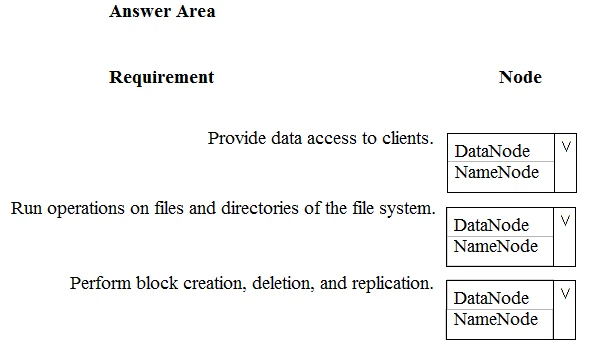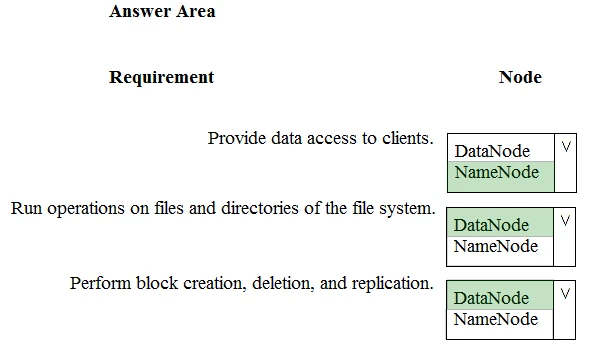Customer organizations have peak usage at different periods during the year.
You need to implement the Azure SQL Database elastic pool to minimize cost.
Which option or options should you configure?
Elastic pools allow for a flexible and cost-efficient way to allocate resources across multiple databases that have varying and unpredictable usage patterns. In this setup, it is crucial to configure both eDTUs (elastic Database Transaction Units) and the maximum data size to ensure that the aggregate resource usage of all databases is adequately managed. This approach helps to optimize performance and control costs by balancing resources among databases as needed.
You are a data engineer. You are designing a Hadoop Distributed File System (HDFS) architecture. You plan to use Microsoft Azure Data Lake as a data storage repository.
You must provision the repository with a resilient data schema. You need to ensure the resiliency of the Azure Data Lake Storage. What should you use? To answer, select the appropriate options in the answer area.
NOTE: Each correct selection is worth one point.
Hot Area:

An HDFS cluster consists of a single NameNode, a master server that manages the file system namespace and regulates access to files by clients.
Box 2: DataNode -
The DataNodes are responsible for serving read and write requests from the file system's clients.
Box 3: DataNode -
The DataNodes perform block creation, deletion, and replication upon instruction from the NameNode.
Note: HDFS has a master/slave architecture. An HDFS cluster consists of a single NameNode, a master server that manages the file system namespace and regulates access to files by clients. In addition, there are a number of DataNodes, usually one per node in the cluster, which manage storage attached to the nodes that they run on. HDFS exposes a file system namespace and allows user data to be stored in files. Internally, a file is split into one or more blocks and these blocks are stored in a set of DataNodes. The NameNode executes file system namespace operations like opening, closing, and renaming files and directories. It also determines the mapping of blocks to DataNodes. The DataNodes are responsible for serving read and write requests from the file system's clients. The DataNodes also perform block creation, deletion, and replication upon instruction from the NameNode.
References:
https://hadoop.apache.org/docs/r1.2.1/hdfs_design.html#NameNode+and+DataNodes

You are developing the data platform for a global retail company. The company operates during normal working hours in each region. The analytical database is used once a week for building sales projections.
Each region maintains its own private virtual network.
Building the sales projections is very resource intensive and generates upwards of 20 terabytes (TB) of data.
Microsoft Azure SQL Databases must be provisioned.
✑ Database provisioning must maximize performance and minimize cost
✑ The daily sales for each region must be stored in an Azure SQL Database instance
✑ Once a day, the data for all regions must be loaded in an analytical Azure SQL Database instance
You need to provision Azure SQL database instances.
How should you provision the database instances? To answer, drag the appropriate Azure SQL products to the correct databases. Each Azure SQL product may be used once, more than once, or not at all. You may need to drag the split bar between panes or scroll to view content.
NOTE: Each correct selection is worth one point.
Select and Place:

SQL Database elastic pools are a simple, cost-effective solution for managing and scaling multiple databases that have varying and unpredictable usage demands. The databases in an elastic pool are on a single Azure SQL Database server and share a set number of resources at a set price. Elastic pools in Azure
SQL Database enable SaaS developers to optimize the price performance for a group of databases within a prescribed budget while delivering performance elasticity for each database.
Box 2: Azure SQL Database Hyperscale
A Hyperscale database is an Azure SQL database in the Hyperscale service tier that is backed by the Hyperscale scale-out storage technology. A Hyperscale database supports up to 100 TB of data and provides high throughput and performance, as well as rapid scaling to adapt to the workload requirements. Scaling is transparent to the application ג€" connectivity, query processing, and so on, work like any other SQL database.
Incorrect Answers:
Azure SQL Database Managed Instance: The managed instance deployment model is designed for customers looking to migrate a large number of apps from on- premises or IaaS, self-built, or ISV provided environment to fully managed PaaS cloud environment, with as low migration effort as possible.
References:
https://docs.microsoft.com/en-us/azure/sql-database/sql-database-elastic-pool https://docs.microsoft.com/en-us/azure/sql-database/sql-database-service-tier-hyperscale-faq

You need to migrate the databases to Microsoft Azure by using a backup process of Microsoft SQL Server.
Which data technology should you use?
Azure SQL Database Managed Instance is the best option for migrating several on-premises Microsoft SQL Server databases to Microsoft Azure using a backup process. Managed Instance provides near 100% compatibility with the latest SQL Server on-premises (Enterprise Edition) Database Engine, ensuring minimal changes to the application and database during the migration. It also offers a native virtual network (VNet) implementation, addressing common security concerns. This deployment option also supports automated patching and high availability, reducing management overhead and total cost of ownership (TCO).
You need to implement a solution that deploys multiple HDInsight clusters with minimal effort.
What should you implement?
To implement a solution that deploys multiple HDInsight clusters with minimal effort, Azure Resource Manager templates are the most suitable choice. These templates allow for the creation and deployment of resources in a single coordinated operation, which includes HDInsight clusters and their dependencies. Additionally, the templates support defining deployment parameters that enable rapid and repeatable cluster creation and destruction, thus saving significant time for the data engineering team.